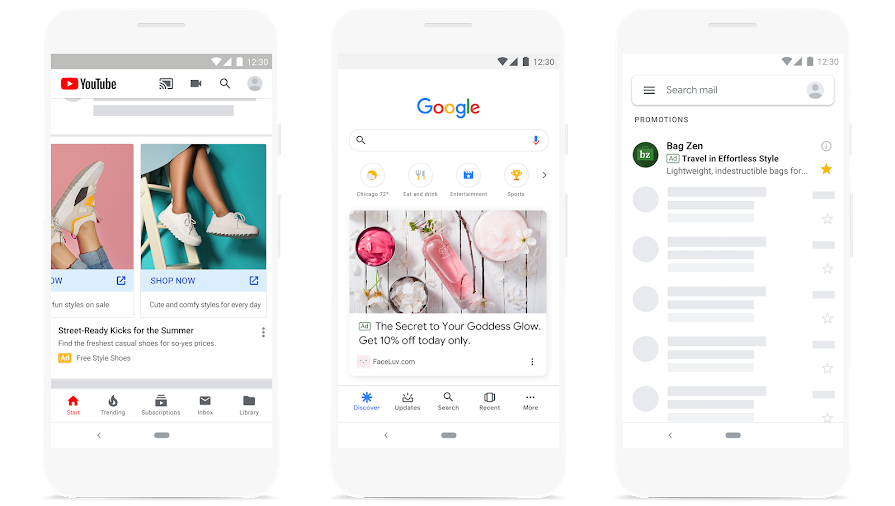 Reading Time: 5 minutes
Reading Time: 5 minutesGoogle is constantly evolving its bevy of digital marketing opportunities, providing more ways than ever to help you get your business in front of the eyes of qualified digital users. If you’re looking to boost your brand awareness, drive traffic to your website, and enhance your audience’s engagement once they find you, one of Google’s most recently updated YouTube ad types may be just the ticket. YouTube video discovery ads can help you with all three of these goals—potentially increasing your conversions in the process.
What Are YouTube Video Discovery Ads?
Commonly referred to as “TrueView video discovery ads,” YouTube discovery ads are an ad type that appears in multiple places throughout YouTube. These ads, known in a former iteration as “In-Display ads,” will promote your video alongside other relevant YouTube videos and shoppable ads. Discovery ads appear nearly identical to the normal slate of YouTube video results in that they feature a thumbnail from your video as well as a brief description and headline, and are mainly distinguishable by a small, yellow “ad” tag on the thumbnail.
This more organic placement is the key difference between discovery ads and the somewhat better-known version of TrueView ads, the in-stream ad. While in-stream ads appear before, during, or after the user’s desired video and appear whether the user wishes to watch an ad or not, discovery ads appear as suggestions alongside other videos in multiple places throughout YouTube. Users drawn in by the thumbnail or text content must click to view the ad, sending interested users likely to convert directly to your video content.
Types of YouTube Discovery Ads Available
Similar to Google’s responsive search ads, discovery ads rely on your input and the platform’s machine learning to create an optimized ad for the most relevant users most likely to be interested in learning more about you. You’ll enter your budget, bids, and targeting information, as well as a link to your video content, your logo, at least one thumbnail image, and as many as five headlines and descriptions; then, the algorithm will assemble an optimized combination of these elements designed to appeal to each relevant user.
Google also uses machine learning to determine ad placement and choose the ideal location for your video ad from several options on the SERP and mobile homepage. Ad placements include:
- Atop video search results on YouTube’s SERP. You may find your ad promoted at the top of organic video results on the SERP, alongside videos that already appeal to your targeted group of users.
- On the YouTube mobile homepage. Similarly, discovery ads may appear among other suggested videos on the homepage that appears when users open YouTube.
- On a video watch page. Discovery ads may also appear within the suggested videos section that populates below a similarly targeted video the user is already watching.
- In Gmail’s social and promotions tab options. Your Discovery ad may also appear in a targeted user’s Gmail, underneath either the social or promotions tabs.
Benefits of Discovery YouTube Ads
YouTube discovery ads were featured front and center at Google Marketing Live last year and are now available to everyone. So, why should you add this updated format to your digital marketing toolkit? We’ll list just a few of the reasons:
- Wide reach. Currently, Google’s Discover efforts are capable of reaching over 800 million people worldwide and counting. With the expansion to Gmail ads, your video ads prove an ever-expanding way to reach potentially interested users.
- Favorable perception. Unlike in-stream ads, discovery ads do not interrupt user videos or otherwise disturb the YouTube experience. As a result, discovery ads enjoy a much more favorable user perception.
- Notable improvements in engagement. Since users must click on an ad that appears semi-natively on their YouTube feed, you’re targeting users who are already showing an active interest in your content. These users are, in some cases, hundreds of times more likely to become “earned subscribers” or participate in “earned views,” meaning that once a targeted user has viewed your ad, they are much more likely to view your other videos or subscribe to your channel.
- Enhanced brand awareness. The above elements can contribute significantly to your ability to promote not only your ads but your other video content across YouTube, Gmail, and other Discovery areas as they become available. The result? Your brand’s unique story is that much more visible to a custom targeted audience already likely to convert into customers.
What’s the Difference Between TrueView Video Discovery Ads and In-Stream Google Ads?
While both formats allow businesses to reach their target audience on the platform, there are key differences between the In-Stream Ads and Discovery Ads. Understanding these distinctions can help marketers make informed decisions about which format best aligns with their advertising goals. Let’s delve into the dissimilarities between In-Stream ads and Discovery ads.
In-Stream Ads: Captivate Viewers During Video Playback
In-Stream ads are video advertisements that play before, during, or after a YouTube video. These ads typically appear within the YouTube player and can last from a few seconds to a few minutes. Viewers encounter In-Stream ads while watching content from YouTube creators, and they have the option to skip the ad after the initial few seconds. Advertisers are only charged if a viewer watches the ad for a specified minimum duration or interacts with it, such as clicking on a call-to-action overlay.
One significant characteristic of In-Stream ads is that they interrupt the viewer’s video-watching experience. As a result, they can be seen as more intrusive compared to other ad formats. However, they can also be highly engaging if the content captures the viewer’s attention and aligns with their interests. In-Stream ads are well-suited for brand awareness campaigns, storytelling, and showcasing products or services through visually compelling video content.
Discovery Ads: Attract Attention Through Search and Recommendations
Discovery ads, on the other hand, operate differently from In-Stream ads. Instead of interrupting video playback, Discovery ads are displayed alongside organic search results or in the recommended video section on YouTube. These ads typically consist of a thumbnail image, headline, and ad text, and they blend seamlessly with the surrounding content. Viewers encounter Discovery ads while actively searching for videos or browsing YouTube for related content.
The distinguishing feature of Discovery ads is that they function as a recommendation or suggestion to viewers, rather than an interruption. They appear when users are exploring content that aligns with their interests, providing an opportunity for advertisers to capture their attention in a non-disruptive manner. Discovery ads are particularly effective for driving engagement, clicks, and traffic to a specific video, channel, or external website. They allow advertisers to pique viewers’ curiosity and encourage them to choose to engage with the ad by clicking on it.
Choosing the Right Format for Your Advertising Goals
When deciding between In-Stream ads and Discovery ads, it’s crucial to consider your specific advertising objectives. In-Stream ads are ideal for maximizing reach and generating brand awareness, especially if your content is visually captivating and can engage viewers quickly. On the other hand, Discovery ads are more suitable for targeting viewers who are actively searching for content related to your products or services, driving engagement and click-through rates.
By understanding the differences between In-Stream ads and Discovery ads, marketers can make informed choices based on their target audience, campaign goals, and desired user experience. Both formats offer unique advantages and can be powerful tools in a comprehensive YouTube advertising strategy. Ultimately, the choice between In-Stream ads and Discovery ads depends on the specific needs of your brand and the type of engagement you aim to achieve with your target audience on YouTube.
Need Help Getting Started with YouTube Discovery Ads?
True optimization of YouTube discovery ads requires the right mix of brand content, creative copy, and targeting know-how. If you’re unsure how to take your brand from content creation to social media advertising campaign building, bid tweaking, budgeting, and more, contact the marketing specialists at Vizion Interactive. We can help you leverage discovery ads to boost engagement and potentially drive conversions in the process.
At Vizion Interactive, we have the expertise, experience, and enthusiasm to get results and keep clients happy! Learn more about how our status as a Google Partner, along with our PPC Management, Google Shopping Ads, Social Media Advertising, Amazon Advertising, and other Paid Media services can increase sales and boost your ROI. But don’t just take our word for it, check out what our clients have to say, along with our case studies.




